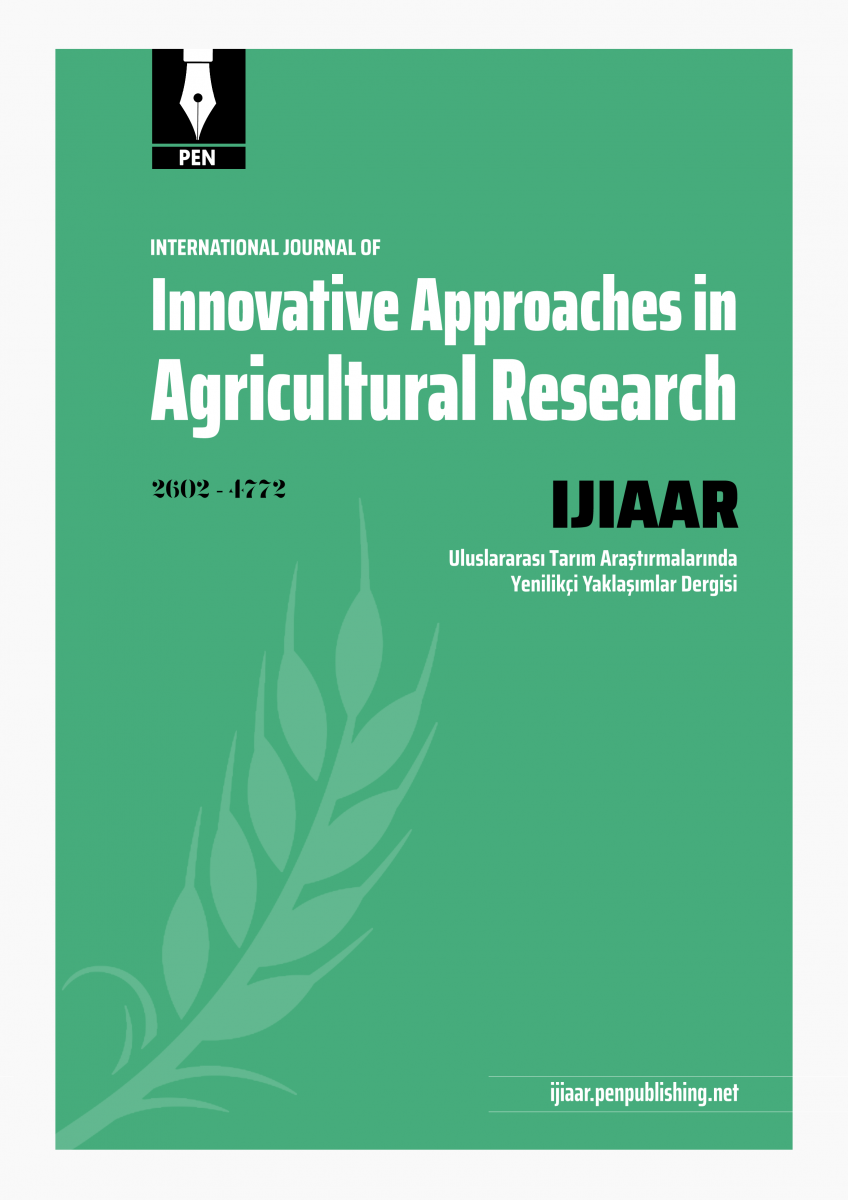- Abu-Reidah, I.M., Jamous, R.M. and Ali-Shtayeh, M.S. (2014). Phytochemistry, Pharmacological Properties and Industrial Application of Rhus coriaria L. Sumac: A Review. Jordan Journal of Biological Sciences JJBS., 7: 233-244. [Google Scholar]
- Anonim (2016). Anonymous (2016). Agricultural Plants That Are Utilized By The Leaf. Ministry of Education of the Republic of Turkey. http://megep.meb.gov.tr/mte_program_modul/moduller/Yapra%C4%9F%C4%B1ndan %20Yararlan%C4%B1lan%20Bitkiler.pdf [Google Scholar]
- Ardalani, H., Moghadam, M., Hadipanah, A., Fotovat, F., Azizi, A. and Soltani, J. (2016). Identification and characterization of chemical composition of Rhus coriaria L. fruit from Hamadan western Iran. J. Herb. Drug, 6, pp. 195-198. [Google Scholar]
- Basoglu, F. and Cemeroglu, B. (1984). Research On The Chemical Composition Of Sumac. Food, 84: 167-172. [Google Scholar]
- Baytop, T. (1999). Treatment with plants in Turkey: past and present. Nobel bookstore, 480s, Istanbul. [Google Scholar]
- Berndes, G. (2006). The contribution of renewables to society. In: Dewulf J, Van Langenhove H (eds) Renewables-Based Technology. John Wiley & Sons, New York, NY, USA, pp. 3–18. [Google Scholar]
- Brunke, E.J., Hammerschmidt, F.J., Schmaus, G. and Akgul, A. (1993). The essential oil of Rhus coriaria L. fruits. Flavour Fragr. J., 8:209-214. [Google Scholar]
- Caliskan, G. (2011). Sumac Extract Powder. Master's Thesis, Ege University Institute Of Natural And Applied Sciences, Izmir. [Google Scholar]
- Duru, S. and Bozdogan Konuskan, D. (2014). Increasing the amount of oleic acid in vegetable oils and its effects on oil quality. Food, 39: 1-7. [Google Scholar]
- Ignaciuk, A., Vöhringer, F., Ruijs, A. and van Ierland, E.C. (2004). Competition between biomass and food production in the presence of energy policies: a partial equilibrium analysis. Energy Policy 34:1127–1138. [Google Scholar]
- Karadas, O. (2019). Determination of Physicochemical Properties of Irradiated Sumac (Rhus coriaria L.) Fruit Oils. MSc. Thesis Tekirdağ Namık Kemal University, Graduate School of Natural and Applied Sciences, Tekirdağ. [Google Scholar]
- Kizil, S. and Turk, M. (2010). Microelement Contents and Fatty Acid Compositions of Rhus coriaria L. and Pistacia terebinthus L. Fruits Spread Commonly in the South Eastern Anatolia Region of Turkey. Nat Prod Res., 24: 92-98. [Google Scholar]
- Kossah, R., Nsabimana, C., Zhao, J.X., Chen, H.Q., Tian, F.W., Zhang, H. and Chen, W. (2009). Comparative Study on the Chemical Composition of Syrian Sumac (Rhus coriaria L.) and Chinese Sumac (Rhus typhina L.) Fruits. Pak. J. Nutr., 8: 1570-1574. [Google Scholar]
- Kossah, R. (2010). Optimization of Extraction of Polyphenols from Syrian Sumac (Rhus Coriaria L.) and Chinese Sumac (Rhus Typhina L.) Fruits Res. J. Of phytochemistery, 4: 146-153. [Google Scholar]
- Kurucu, S., Koyuncu, M., Guvenc, A., Baser, K.H.C and Ozek, T. (1993). The Essential Oils of Rhus coriaria L. (Sumac). J. Essent. Oil. Res., 5:481-486. [Google Scholar]
- Mavlyanov, S.M., Islambekov, S.Y., Karimdzhanov, A.K. and Ismaikov, A.I. (1997). Anthocyans and organic acids of the fruits of some species of sumac. Chem Nat Compd., 33, 209. [Google Scholar]
- Mazaheri, T.M., Hesarinejad, M.A., Razavi, S.M.A., Mohammadian, R. and Poorkian, S. (2017). Comparing physicochemical properties and antioxidant potential of sumac from Iran and turkey. MOJ Food Process Technol., 5(2):288-294. [Google Scholar]
- Oke, M.O., Awonorin, S.O., Sanni, L.O., Akanbi, C.T. and Abioye, A.O. (2007). Determination of Some Selected Engineering Properties of Sweet Potato Cuts as Function of Temperature. Journal of Food Technology, 5(1):66–70. [Google Scholar]
- Ozcan, M. Haciseferogullari, H. (2004). Acondiment Sumac (Rhus coriaria L.) Fruits: Some Physico-Chemical Properties. Bul. J. Plant Physiol, 30:74-84. [Google Scholar]
- Ozguven, F. and Vursavus, K. (2005). Some physical, mechanical and aerodynamic properties of pine (Pinus pinea) nuts. Journal of Food Engineering, 68(2):191–196. [Google Scholar]
- Perlack, R.D. (2006). Biomass as feedstock for a bioenergy and bioproducts industry: The technical feasability of a billion-ton annual supply. United States Department of Energy, Washington, DC, USA. [Google Scholar]
- Sakhr, K. and Khatib, S.E. (2020). Physiochemical properties and medicinal, nutritional and industrial applications of Lebanese Sumac (Syrian Sumac - Rhus coriaria): A review. Heliyon, 6(1): e03207. [Google Scholar]
- Shabbir, A. (2012). Rhus Coriaria linn, a Plant of medicinal, nutritional and industrial importance: a review. J. Anim. Plant Sci., 22: 505–512. [Google Scholar]
- USDA (2016). United State Department of Agricultur. Natural Resource Conservation Service.https://plants.usda.gov/java/ClassificationServlet?source=display&classid=RHUS. [Google Scholar]
- Under, D. and Saltan, F.Z. (2019). Sumac and Its Important Biological Effects. Çukurova J. Agric. Food Sci. 34(1): 51-60. [Google Scholar]
- Unver, A. and Ozcan, M.M. (2010). Fatty Acid Composition of Seed and Pericarp of Sumach (Rhus coriaria L.) Grown Wild in Different Regions of Turkey. J Food Agric Environ., 8: 31-33. [Google Scholar]
- Van Wyk, B.E. and Wink, M. (2004). Medicinal plants of the World. Timber Press, Portland, OR, USA. [Google Scholar]
- Yuksel, E. and Kaplan, İ. (2018). Examination Of Phytochemical Components Of Sumac Plant Grown In Tunceli Province. Master's Thesis, Munzur University Institute Of Natural Sciences, Tunceli. [Google Scholar]
- Zargham, H. and Zargham, R. (2008). Tannin Extracted from Sumac Inhibits Vascular Smooth Muscle Cell Migration. Medical J Malaysia, 11: 119-123. [Google Scholar]
|

